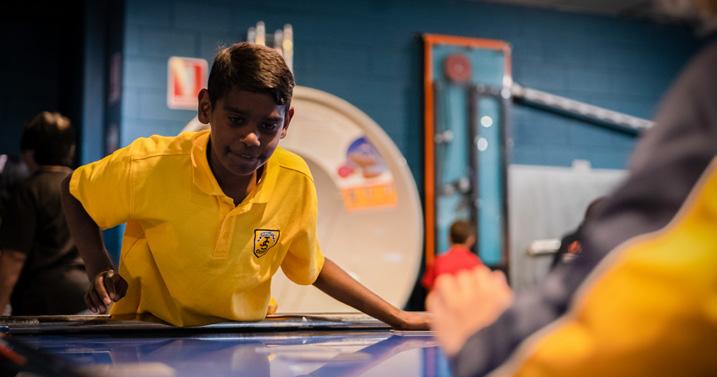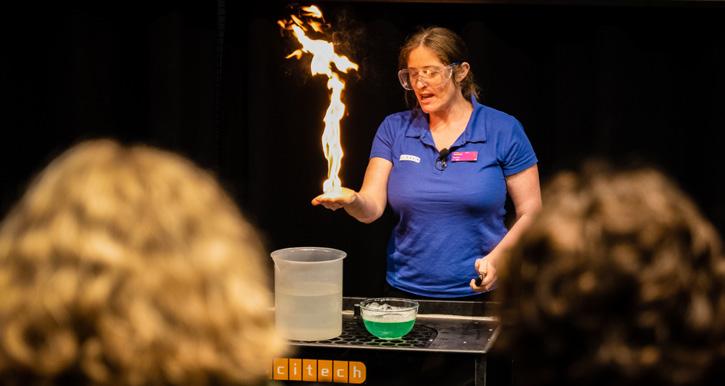
11 minute read
pOWERfuL pRObLEm-SOLVING IN SCIENCE
from SCIOS July 2023 Volume 70
by STAWA
About the Authors
Shyam Drury is a Professional Learning Consultant at Scitech. He developed the highly successful Lighthouse Maths program, training teachers in a Powerful ProblemSolving approach to teaching mathematics. He worked previously as a high school mathematics teacher and is currently studying a PhD in mathematics education at the University of Notre Dame Australia.
Lucas Black brings his 15 years of experience with him to Scitech Professional Learning. In his last 3 years with Scitech Lucas has worked with teachers in many schools across WA to enhance the pedagogical delivery of Science, Maths and Digital Technologies.
to discovery, problem-solving serves as the key to unlocking its profound mysteries and shaping the future of human knowledge.
In this article, we discuss an approach we have been using to implement problem-solving focussed lessons, and how this can be applied in the context of a primary science classroom. Our approach is based on the Five Practices for Orchestrating Productive Task-Based Discussions in Science outlined by Cartier et al. (2013). We will outline the use of these five practices through an example lesson, as well as addressing some additional considerations.
problem-solving tasks and lesson goals
In the dynamic realm of science, problem-solving takes centre stage as a vital skillset. The science classroom provides a unique platform for students to engage in a captivating journey of exploration and inquiry. Whether deciphering complex equations, analysing intricate data sets, or unravelling the mysteries of the natural world, problem-solving lies at the heart of scientific endeavours. It empowers students to think critically, apply their knowledge, and develop innovative solutions to real-world challenges. By honing their problemsolving abilities, students not only enhance their scientific proficiency but also cultivate a broader set of skills that are invaluable in navigating the complexities of an ever-evolving world. As science opens the door
The first step in fostering authentic problem-solving is selecting the right task and matching it to an appropriate lesson goal. The task should aim to be accessible to all students, based on prior knowledge, but provide challenge through requiring the students to make decisions. Successful completion of the task must be centred on specific scientific concepts, providing the basis for a discussion the teacher can facilitate to make the concepts explicit and deepen understanding. Here we provide an example task that could be used while teaching to the Year 3 content descriptors Science Inquiry Skills: Planning and Conducting and Physical Science: Heat can be produced in many ways and can move from one object to another:
Which material conducts heat best?
materials supplied:
• metal spoon
• wooden spoon
• plastic spoon
Equipment: One per group:
• Digital thermometer with probe
• Stopwatch
• Bowl for boiling water.
practise 1: Anticipation
Anticipation is how the teacher prepares for the problem-solving lesson. The teacher needs to thoroughly consider the task and identify:
Instructions:
• Determine which of the materials is the best heat conductor.
• Work out how you will use the equipment provided to measure how well materials conduct heat. To make comparisons you will need to conduct multiple tests. Consider what you will change, measure, and keep the same for fair testing.
• Record important data that can be used as evidence. Compare the data from each of the tests to prove which material is the best heat conductor.
• Provide justification that you have used a fair test. We understand that suitable safety precautions must be taken and discussed with students in a task involving heat. We have not addressed these directly, as we assume teachers to be competent to address these and choose to keep the content of this article focused on the less obvious information being presented.
For this task, our lesson goal understandings are:
1. Correct conclusions about which material conducts best can only be made when a fair test is conducted.
2. A fair test needs to keep all elements the same other than the one you are deliberately changing. (In technical terms, a fair test needs to control for all independent variables other than the one being tested.)
Ideas around the best way to display data clearly and convincingly to prove a conclusion are also suitable goals for this task, but it is important to limit the number of goals so that they can be addressed adequately, with focus. Which goal to focus on is an important decision the teacher must make based on prior assessment of student’s understanding and judgements about what concepts to focus on next. We have chosen the above goals for the purpose of illustration.
• Expected and appropriate strategies for solving the task, and how to move through each of the steps.
• Likely mistakes pupils might make, and how to correct them.
• Levels of efficiency and accuracy in task completion, and how to move from lower ones to higher ones.
• How to support or extend students as required.
It can be very helpful, if opportunity permits, to complete the task and/or to discuss the task with colleagues to help in identifying these features. A main appropriate strategy we have identified for determining the best heat conductor is:
1. Measure the temperature of one end of the material. Record value.
2. Place the other end of the material on the hot plate for a fixed period (e.g., 5-10 minutes). (Using tongs and appropriate safety equipment under supervision).
3. Measure the temperature of the material at the opposite end. Record value.
4. Repeat steps 1-3 for each material.
5. Determine the change in temperature of each material by calculating the difference between the starting and finishing temperatures for each.
6. Identify the best heat conductor as the material whose temperature changed the most.
Along with identifying the likely mistakes and inefficiencies, it is important to prepare prompts to get students back on track, progressing with the task. We recommend, in most cases, teachers use questions to prompt thinking rather than statements. This is because teachers should aim to provide expert guidance to student thinking without taking away all the opportunities for students to do the thinking themselves. Here is a list of some possible mistakes we have predicted for the students along with prompts:
Student mistake: Teacher prompt:
Measure the temperature of the material close to the heat source.
Only measure temperature once per material.
Conductivity is how well a material transfers heat. What do you need to change to make sure you are measuring the heat transferred through the material?
How will you know how much the material heated up if you don’t know how hot it was at first?
Use inconsistent intervals. Can we make a fair comparison between one material that had five minutes to heat up and another that had ten minutes? Why not? What do you need to change about what you are doing?
Do not record measurements systematically.
Do not know how to interpret data and relate it to the question to make a conclusion.
How will you make sure you have the data you need to make comparisons and come to a conclusion? How will you know later which values were for which recording?
Refer students back to initial question. What are you trying to figure out? How can you work out the change in temperature for each material? Would a high change or low change be a sign of good heat conductivity?
When the teacher anticipates student solutions, errors, and misconceptions as deeply as they can, they are able to prepare good prompts, thereby reducing how much improvisation is required during the lesson. This will make the teacher more efficient and effective in supporting students through the task. We have only demonstrated anticipation and preparation of prompts for mistakes, but the more the teacher can think through all the various features listed above the more effective they will be. For example, a teacher can prepare prompts for how to help students move forward in the main strategy when they get stuck at key steps.
Enabling and extending prompts
It is helpful to prepare simpler and more complex versions of the task, to provide for differentiation. Groups or students who are unable to engage with the main task can be given an enabling prompt, and students who complete the task early can be given an extending prompt. This idea is drawn from the work of Sullivan et al. (2015) who developed it for use in supporting the use of challenging tasks in mathematics. Enabling prompts should simplify the main task by reducing steps, complexity, or number of decisions in the task. Completion of the enabling prompt ideally allow students to complete the main task.
Extending prompts should connect to the idea in the main task but extend it, potentially incorporating some related concepts. Some enabling prompts for this task might be:
• Choose a spoon, measure the temperature of the handle. Place the spoon in the bowl (handle out) of hot water for 10 minutes, then measure temperature of the handle again. Use these two temperatures to figure out how much the material heated up.
• Do this for another spoon. Compare how much this material heated up. Work out which one is a better heat conductor.
While some extending prompts might be: practices 2, 3 & 4: monitoring, Selecting and Sequencing
• How could you represent your findings using a graph to make it easier to interpret?
• How could you find out how well the material holds heat?
Anticipating all happens before the lesson. The lesson itself begins with a launch which should be a clear and concise description of the task, allowing students to get started. Often, in these powerful problem-solving sessions, students will work in groups so they can support and learn from each other. Having students in groups also makes it easier for the teacher to monitor the activity of the whole class and get around to all students for support. Monitoring is the process of observing the activity of the class and visiting groups to check on progress and provide prompts as necessary. The teacher should be careful to only provide just enough support to move student thinking forward to the next step, and then leave them to continue working it out for themselves. Some groups and students may not need any prompting. The teacher also makes notes during this time, on which groups have used which strategies (and/or encountered which mistakes) in preparation for a whole class discussion. The teacher will then select a few groups (usually 2-3) to present their findings at the end of the groupwork to use as a basis for a discussion targeting the lesson goals. The teacher can prepare the groups by letting them know they will be called upon and what they will be asked to share. The teacher will carefully determine the order in which the groups present during the whole class discussion to clearly lead students through the core ideas in a way that logically build upon each other. For example, in this lesson, a teacher might choose the following three groups in order:
1. Group 1: Initially measured temperature close to the heat source but corrected their error with prompting from the teacher. They can clearly articulate the meaning of conductivity and why measuring away from the heat source is necessary.
2. Group 2: Group made errors in fair testing but corrected them and can explain reasoning.
3. Group 3: Produced a clear and sound argument with well displayed data.
practice 5: Connecting
In the fifth practice, Connecting, the teacher makes connections between different student presentations, and connects what is being presented with the learning goal. The teacher uses well-crafted questions and statements to make the central concepts explicit and understandable for the class. The teacher should prepare some key questions before the lesson based on their anticipations and understanding of the concepts, then weave these into a discussion built on student presentations. The discussion might go something like this:
Group1 Teacher asks group to describe to the class the change they made in where they measured the temperature and why that was important.
Group explains. Teacher and class discuss.
Key question: Why was it important to measure the temperature at the opposite end from the heat source?
Group 2 Teacher asks group to explain their process for solving the problem and what changes they needed to make. Group explains. Teacher and class discuss.
Key questions: Why did the time between measurements need to be the same for each test? Why did we need to measure the temperature before heating? What did you need to do when recording data to make it usable?
Group 3 Teacher asks group to take class through their whole solution.
Group explains. Teacher and class discuss.
Teacher stops presentation at key points when they have demonstrated correct practices. At each point teacher can ask class to discuss/explain why they did it that way and why it was important. (Connecting to issues addressed in previous presentations.)
Key question: How does the data prove that the metal spoon is the best conductor?
Considerations and conclusion
In selecting and implementing a problem-solving lesson like the one described here, there are many factors to consider. The teacher needs to take into account how much the students know, how much experience they have with challenging unstructured problems, as well as the classroom culture. In terms of classroom culture, time and effort needs to be spent to build a space where students feel safe to take risks and make mistakes, and safe to share these with each other. The classroom culture needs to be one in which students feel they are all working together to develop their understanding, without judgement, shame or competition.
Importantly, cognitive load theory explains that students have finite limits to working memory (Sweller, 2011), that is, there is only so much a person can hold in their mind at once. If a student lacks the fundamental understandings necessary that allow them to use their cognitive capacity to focus on problem-solving, they can be overwhelmed stuck in unproductive frustration. This means that ideally students need to have mastered all the prerequisite understandings (e.g., understanding of heat conductivity, what makes a fair test etc.) to be able to have enough free working memory to deal with the decisions they need to make in applying this knowledge in the context of this problem. In practice, there is no way to guarantee all students have achieved mastery of the necessary concepts before implementing a challenging problem, so teachers should aim for the majority of students to have achieved mastery and have enabling prompts ready to reduce the cognitive demand for those who have not.
The sequence of the five practices builds in concert to allow for intentional teaching and learning practices in the classroom. When incorporated into a lesson effectively a teacher can provide students with a rich problem-solving opportunity that facilitates student-led exploration, discovery, and discussion of curriculum content. This approach to learning can be very exciting for students and allows a connective learning process that students enjoy because it incorporates explicit practices with student autonomy and decision-making processes. Additionally, teachers skilled in collecting qualitative and anecdotal assessment evidence will find that the process provides ample opportunity to understand their students as learners. While all these reasons are beneficial to the classroom, perhaps the real benefit to implementing the five practices in a science classroom is the opportunity for students to ask questions, test and try new things, make and reflect on observations, and communicate their findings with others as scientists.
References
1. Cartier, J. L., Smith, M. S., Stein, M. K., & Ross, D. K. (2013). 5 practices for orchestrating productive task-based discussions in science. National Council of Teachers of Mathematics.
2. Sullivan, P., Askew, M., Cheeseman, J., Clarke, D., Mornane, A., Roche, A., & Walker, N. (2015). Supporting teachers in structuring mathematics lessons involving challenging tasks. Journal of Mathematics Teacher Education, 18, 123-140.
3. Sweller, J. (2011). Cognitive load theory. In Psychology of learning and motivation (Vol. 55, pp. 37-76). Elsevier.











